The Tangerine-Flake Baby
Whither goest thou, America, in thy shiny car in the night?
– Jakc Kerouac, in “On the Road”
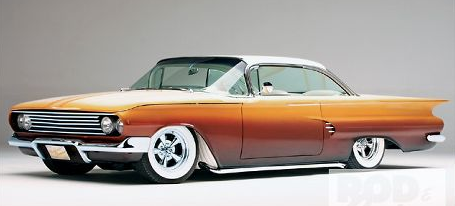
(The real Tangerine Flake Baby, as created by Kalifornia Kustom auto madman Ed “Big Daddy” Roth. Seeing this car, and talking to Roth, gave New Journalist Tom Wolfe the inspiration to publish his first collection of essays about the America that happened when no one was looking)
In 1965, Tom Wolfe was writing for Esquire in his adopted home in Manhattan. Raven and Big Momma dragged the three kids to New York for a day trip from Grandma’s house in Millburn across the River to show us the place they had met and courted. Wolfe was standing in front of a building- I have no idea which one- in Mid-town. I recognized him due to his vanilla-colored suit. I wish I had said something to him to anchor the moment, but it was a completely random encounter.
I wish I could say that it changed my life, or presaged something, but I am not aware that it did, except as a random moment in what appears to be a completely random life.
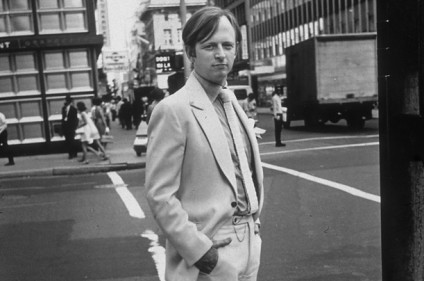
(Writer Tom Wolfe almost the way I saw him on the street in Manhattan, 1965.)
Tom was in the process of applying his considerable observational skills and novel punctuation to the American parade. The automobile already has a long shadow in popular literature- Jack Kerouac’s classic speed-induced road trip was one that caught the attention of the avant guard- but in 1963, Tom Wolfe had a deadline for an article about a car show and a case of writer’s block.
As the time grew closer, Wolfe compiled his notes, without much concern for the nicities of standard grammar and mailed them to his editor at Esquire, standard conventions of writing, and submitted them to his editor Byron Dobell. They say he removed the heading “Dear Byron” and ran the notes as the essay.
.
The Kandy-Kolored Tangerine-Flake Streamline Baby became the flagship tale of the seminal collection of stories published in book form in 1965. There was no unifying theme to them- but the stand-outs in the book was the one about the car show, and the two most influential hot-rod stylists of the day, George Barris and Ed “Big Daddy” Roth. Perhaps the strongest essay in the book, though, was titled “The Last American Hero,” and featured a profile for former moonshine runner and NASCAR star Junior Johnson.
The latter was made into a movie starring Jeff Bridges, and marks perhaps the first cross-over of Southern racing culture to the larger society. Dad and his pals would have represented the Watkins Glenn crowd- the European Grand Prix, a picnic hamper in wicket basket and champagne. Junior represented speed and anarchy.
The street racing and smuggling were both illegal, and that placed all of us in our shiny cars against the authorities- a rich vein of which would later be mined by the Smokey and the Bandit films and the television exploits of the Dukes of Hazzard County or Starsky and Hutch.
Barris and Roth represent starkly different views of the hot rod- the innovative discipline that souped -up stock Detroit iron and turned them into road missiles for both fun and profit. The three men, in sum represented the spectrum of the American automotive tradition.
Barris was the stylist, and artist, really. He harked back to the great coach-builders like Duesenberg of an earlier generation. His most famous creation was based on a 1955 futuristic concept car called the Lincoln Futura. It was built entirely by hand in Turin, Italy at a cost of $250,000. It never made it into production, and after fulfilling its mission to enhance the reputation of the Ford Advanced Design Ship, languished in storage.
In the mid-1960’s, Barris acquired it for a single dollar. That is the same value the Navy put on my last aircraft carrier, the USS Forestall. Funny how function and style can come down in the world.
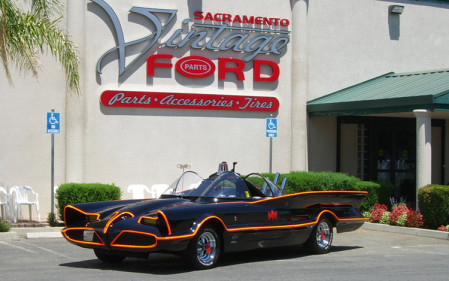
In 1965, the producers of the Biff! Kapow! Batman television show needed a credible Batmobile, and Barris stepped up. In three weeks his company delivered the car that will forever be known as Adam West’s urban ride, The car was such a huge success that Barris and the producers of Batman decided to build copies for display at car shows, drag-strips and appearances for breathless fans.
I never met George, though I would like to. He is still around. “Big Daddy” Ed Roth is not. Roth built his cars to run and be cool. Chopped, channeled and sectioned was the tradition he represented, the real American hot-rodder. He was in his Rat Fink phase, grotesque cartoon figures crammed into impossibly powerful quarter-mile drag machines. The Revelle plastic model company began to issue kits that kids like me could assemble at home with the aid of powerful and aromatic glues.
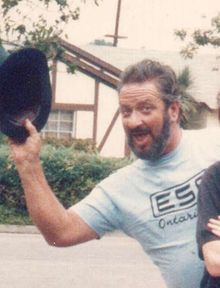
(Big Daddy Ed Roth.)
Ed was making an appearance at one of the shows in Detroit, and I stood in line, dutifully. Never having come this close to cultural greatness (with possible exceptions of George Romney and Tom Wolfe,) I stammered when it was my turn to get an autograph:
“Now that I have met you,” I said in wonder “I will have to buy more of your merchandise.”
Big Daddy looked at me with dark manic eyes.
“Why?” he said.
It was not much different, in its way, than what Wolfe said about the car show where he saw the 1960 hot rod that Big Daddy had transformed into the Tangerine-flake baby.
“I went to the Hot Rod & Custom Car show and wrote a story that would have suited any of the totem newspapers. All the totem newspapers would regard one of these shows as a sideshow, a panopticon, for creeps and kooks; not even wealthy, eccentric creeps and kooks, which would be all right, but lower class creeps and nutballs with dermatitic skin and ratty hair. The totem story usually makes what is known as “gentle fun” of this, which is a way of saying, don’t worry, these people are nothing.”
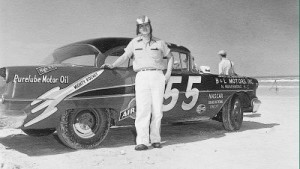
(Junior Johnson, big as life).
Well, Mr. Wolfe’s editors might have been right in looking down at the real America, but Tom knew something profound and painfully true. We are all crazy- but as he found when he wrote about Junior Johnson, and later the Astronauts in The Right Stuff, there is something powerfully right about how we do things.
Or did, anyway.
For contextual comparison, the show where I got to talk to Big Daddy Roth was in 1965, the year of Wolfes first outing in New Journalism. There was something else that was sort of new. I t was on this date just two years alter that the Detroit police decided to bust a Blind Pig on 12th Street downtown. The police stormed the bar, rounded up and arrested 85 black men and began loading them into vans.
The riot that ensued resulted in the mobilization of the Michigan National Guard and the deployment of elements of the regular 82nd Airborne Division. The National Guardsmen fired more than 150,000 rounds over the next four days, and 43 were killed and many more wounded.
Dad had already got us out to the suburbs, but the White Flight that followed caused the city’s population to plunge from 1.6 million to 992,000 in just a few years.
I talked to a pal up there who said things might be turning around again. It is possible, and I hope so. But it was an awful far way down.
More about Fins tomorrow, and the relationship between the Aviation of the Cold War and the futurist look that drove America into the brick wall of the 1973 Oil Shock. Or maybe we will do Hippies in Volkswagons or Javelin’s next, I dunno. I get lost sometimes.
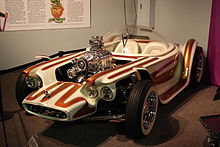
(Big Daddy’s Beatnik Bandit, circa 1960)
Copyright 2014 Vic Socotra
www.vicsocotra.com
Twitter: @jayare303
